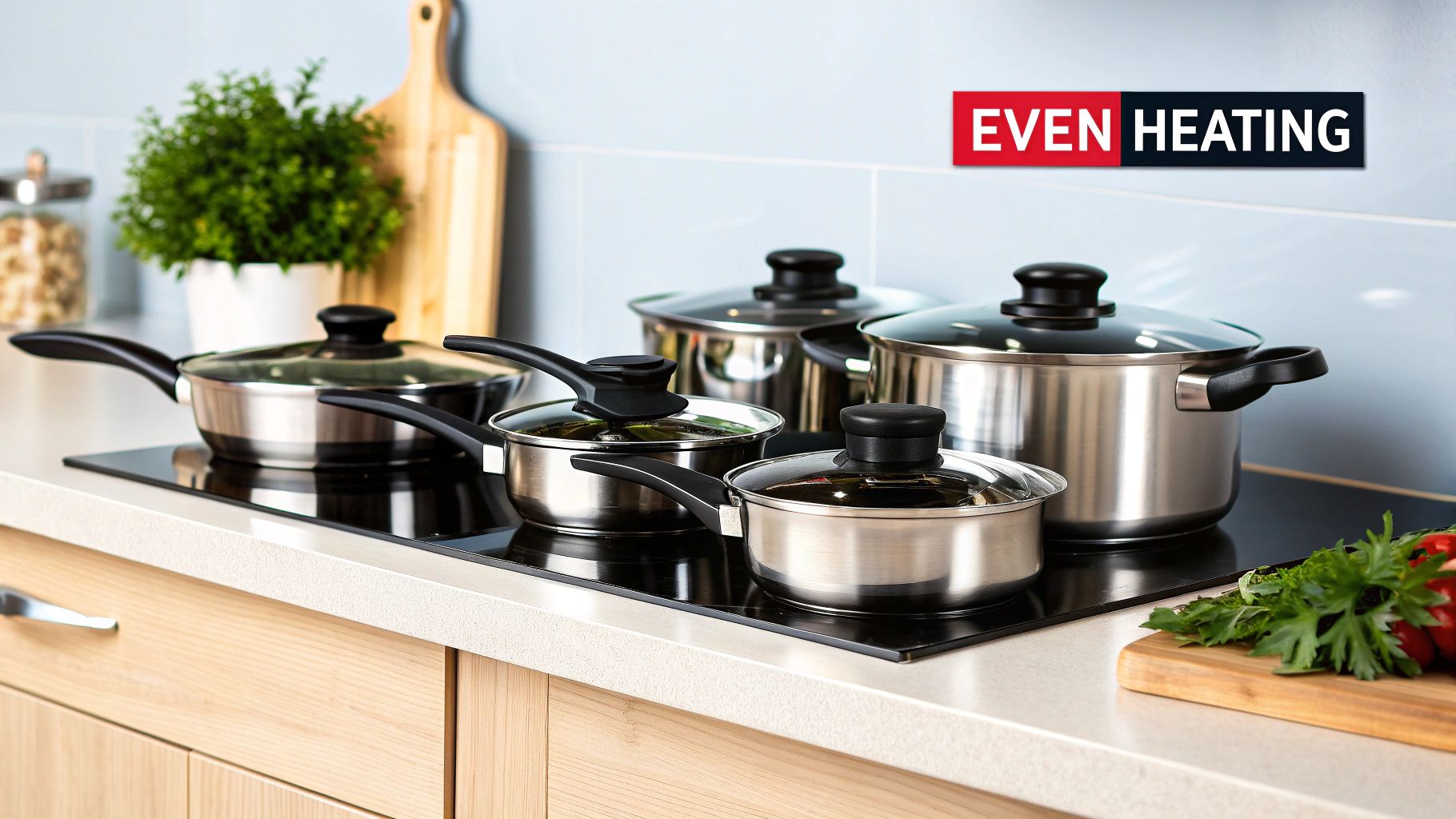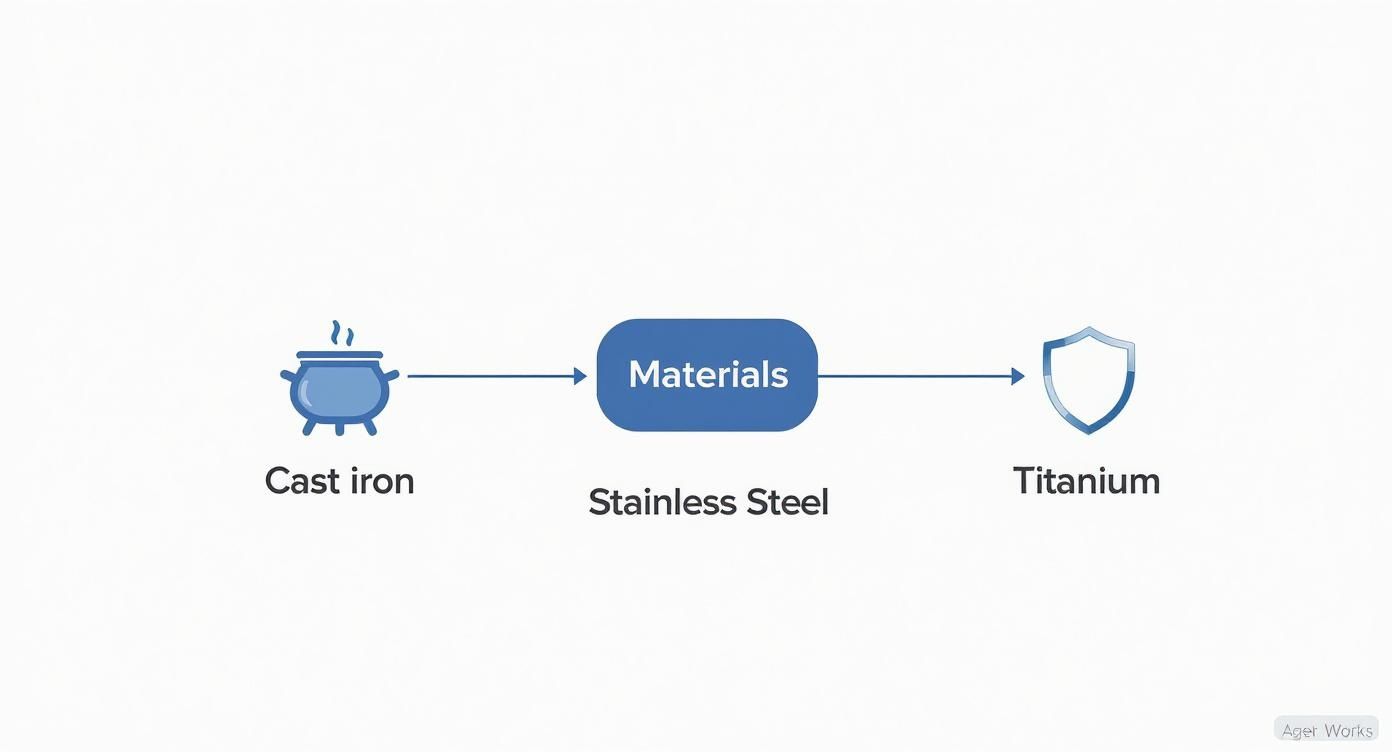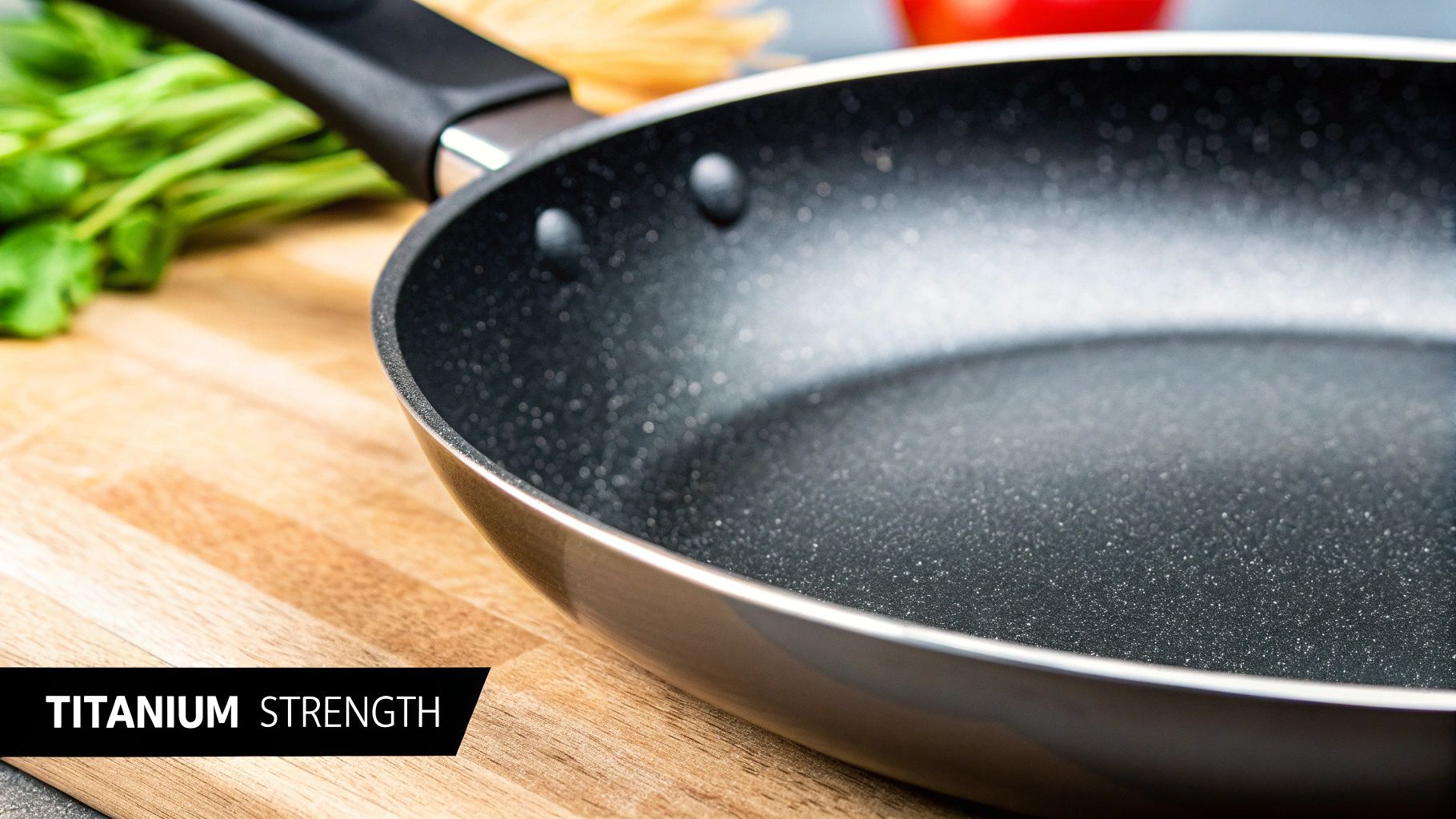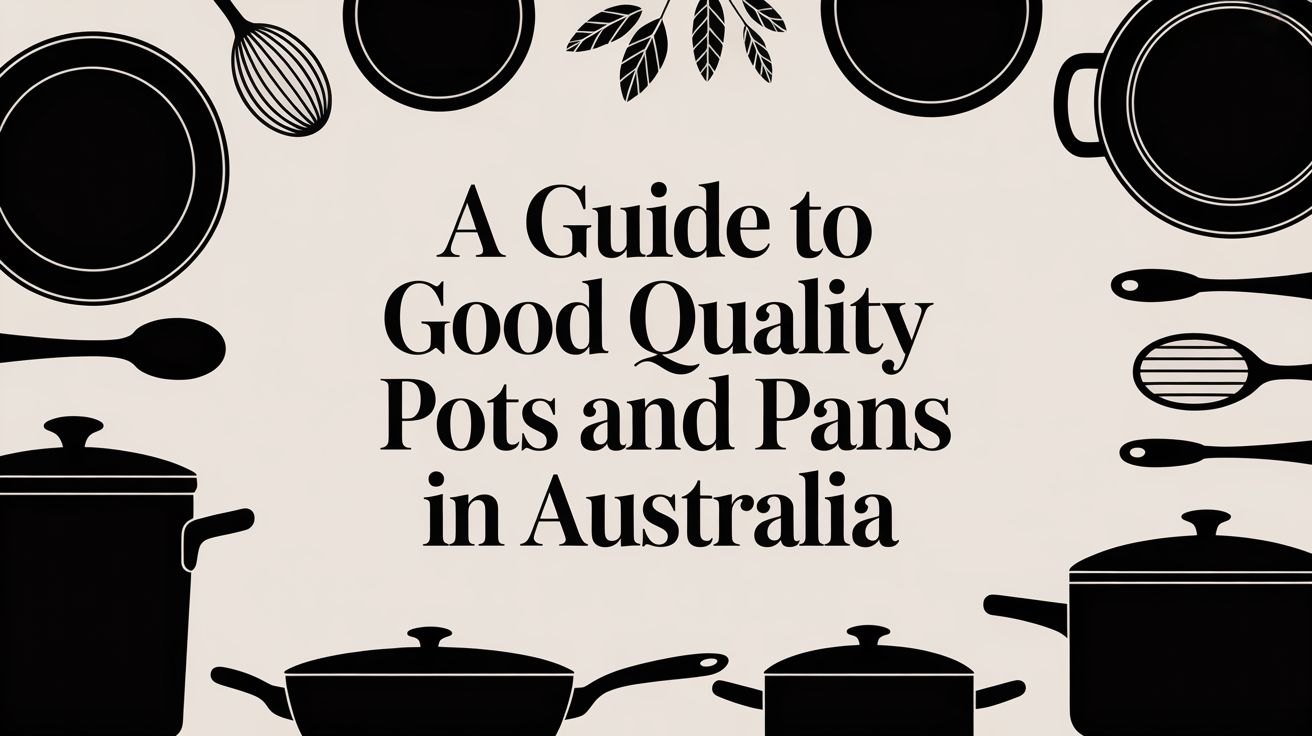It’s easy to think a high price tag equals quality, but what really defines good pots and pans comes down to three things: material performance, heat conductivity, and durable construction. Get these right, and you'll have cookware that heats evenly, responds instantly to temperature changes, and stands up to years of use. It's the kind of gear that can genuinely transform how you cook.
What Actually Makes Cookware Good Quality?

Before we start talking brands, let's get to the heart of what separates a true kitchen workhorse from something that just clutters up your cabinet. Real quality isn't about the logo stamped on the handle; it’s about tangible performance that makes cooking more precise, predictable, and—most importantly—enjoyable.
Think of it like comparing a proper chef’s knife to a butter knife. Sure, both can cut, but only one gives you the effortless control you need to do the job well.
The same idea applies to cookware. When you invest in good quality pots and pans, you’re not just buying an object; you're paying for results. We’re talking beautifully seared steaks without annoying hot spots, delicate sauces that never scorch, and a steady, even heat that holds a perfect simmer. That kind of reliability only comes from a smart combination of material science and practical design.
The Core Pillars of Quality Cookware
Ultimately, high-performance cookware boils down to a few key characteristics. Once you understand these, you can look straight past the marketing hype and spot true value on the shelf.
- Superior Heat Conductivity: This is all about how quickly and evenly a pan gets hot. Materials like copper and aluminium are fantastic conductors, spreading heat rapidly. Stainless steel, on the other hand, is a bit slower. That’s why you’ll often see high-end cookware bonding these materials in layers—to give you the best of both worlds.
- Excellent Heat Retention: Once the pan is hot, how well does it stay hot? Cast iron is the undisputed king here. It holds its temperature incredibly well, which is why it’s perfect for searing a steak; the pan won't suddenly go cold the moment you drop the meat in.
- Durability and Longevity: A quality pan has to be tough enough to resist warping, scratching, and corrosion. Hard-wearing materials like stainless steel and titanium are prized for their sheer strength, ensuring your investment will quite literally last a lifetime.
Why It Matters to Australian Kitchens
This growing focus on performance and durability is behind a huge shift in how we’re spending our money. The Australian cookware market recently hit a massive USD 664.44 million in a single year and is on track to nearly double by 2033.
This isn’t just a random statistic; it shows a real passion for home cooking is on the rise. More and more Aussies are choosing to equip their kitchens with premium, long-lasting tools that deliver real results. You can read more about this growing movement in the full cookware market report.
What Are the Best Cookware Materials Made Of?
The material a pot or pan is made from is its DNA. It dictates how it heats up, how it holds that heat, and ultimately, how it performs in your kitchen. Choosing the right one can feel a bit like a high-school science experiment, but it's pretty simple once you get a feel for the unique strengths of each.
Think of it this way: you wouldn't use a cricket bat to play tennis. In the same way, different cookware materials are champions at different jobs. Let's break down the most popular options to help you build a winning team for your kitchen.
The Traditional Heavyweights
Some materials have been kitchen staples for generations, and for good reason. They offer rock-solid, reliable performance and have more than stood the test of time.
- Stainless Steel: This is the workhorse of the kitchen. It’s tough, non-reactive (so it won’t mess with the flavour of acidic foods), and almost impossible to destroy. It’s brilliant for getting that perfect golden-brown sear on a steak. The one catch? On its own, stainless steel isn't a great heat conductor. That’s why you’ll often find premium pans with an aluminium or copper core sandwiched in the base to banish hot spots and ensure even cooking.
- Cast Iron: If you want a pan that holds onto heat like nothing else, this is it. Cast iron is the undisputed champion of searing, frying, and slow-cooking. It might take a little while to heat up, but once it does, it delivers steady, even heat that’s perfect for everything from a steak to a skillet brownie. It does need a bit of TLC (a process called seasoning), but a well-loved cast iron pan will genuinely last a lifetime—or even longer.
- Copper: Copper is the sprinter of the cookware world. It heats up in a flash and cools down just as quickly, giving you incredible control over the temperature. Professional chefs adore it for this very reason, as it’s perfect for delicate sauces or fish where a few degrees can make all the difference. The trade-off is that it’s usually pricey and needs a regular polish to keep its signature shine.
Cookware Material Comparison
To make things a little clearer, here’s a quick-reference table comparing the pros and cons of these popular materials. Think of this as your cheat sheet for understanding which material suits which task.
| Material | Heat Conductivity | Durability | Reactivity | Best For |
|---|---|---|---|---|
| Stainless Steel | Poor (needs a core) | Excellent | Non-Reactive | Searing, browning, everyday cooking |
| Cast Iron | Moderate | Excellent | Reactive (if unseasoned) | Searing, frying, slow-cooking |
| Copper | Excellent | Good | Reactive | Delicate sauces, precise temperature control |
| Aluminium | Very Good | Fair | Reactive | All-purpose cooking (often coated) |
| Titanium | Excellent (in core) | Exceptional | Non-Reactive | Non-stick cooking, daily use, healthy cooking |
Each of these materials has a place in a well-equipped kitchen, but modern innovations have pushed the boundaries of what we can expect from our daily pans, especially when it comes to non-stick.
The Evolution of Non-Stick Surfaces
Let's be honest, nothing beats a non-stick pan for sheer convenience. It turns cooking tricky foods like eggs and pancakes into a breeze and makes washing up so much easier. But not all non-stick coatings are created equal, and this is where it pays to know what you’re buying.
The real game-changer in non-stick isn't just about food sliding off easily; it's about creating surfaces that are tough, long-lasting, and free from the health worries tied to older coatings. Modern cookware puts safety right alongside convenience.
We’ve all had those old non-stick pans that were great for a few months before a stray fork or metal spatula left a scratch, and things started sticking. That fragility led to valid concerns about their lifespan and the potential for chemicals to be released if they got too hot.
Thankfully, technology has moved on. The new generation of non-stick cookware tackles these problems head-on. By reinforcing the cooking surface with incredibly strong materials, manufacturers have created pans that are leagues ahead in durability. This brings us to a standout innovation in the search for the best healthy cooking pans.
Why Titanium Changes Everything
Titanium reinforcement is one of the biggest leaps forward in modern cookware. A good way to picture it is like adding steel rebar to concrete—the tiny titanium particles create a super-strong, resilient matrix within the non-stick coating itself.
This reinforcement delivers some massive benefits:
- Unbelievable Durability: Pans with titanium-infused surfaces are far more resistant to scratches and general wear and tear. You can often use metal utensils without a second thought.
- Longer Lifespan: That added toughness means the non-stick magic lasts so much longer. You get a pan that performs like new for years, not just a few months.
- A Safer Cook: A more stable surface that isn't prone to chipping or flaking simply provides a safer cooking experience, free from the old worries of degrading coatings.
This brilliant combination of convenience, toughness, and safety makes titanium-reinforced cookware an incredible choice for anyone wanting good quality pots and pans that can stand up to the rigours of a busy Australian kitchen. It gives you that effortless food release we all want, but with the built-in strength to go the distance.
Key Features to Look for Beyond the Material
While the metal itself is the heart of any good pot or pan, it's the smaller design details that separate a decent piece of cookware from a truly great one. These features might not be the first thing you notice, but they make all the difference in how a pan feels, performs, and cleans up after a meal.
First and foremost, look at the base. A thick, heavy bottom is non-negotiable. Quality pans often have a multi-layered, bonded base that acts like a heat diffuser, spreading warmth evenly across the entire cooking surface. A flimsy base, on the other hand, is a recipe for disaster. It creates intense hot spots that will burn your garlic in seconds while the rest of the pan is still catching up.
This infographic breaks down the core strengths of different popular materials, showing how each contributes to a well-rounded kitchen.

As you can see, there are always trade-offs. Cast iron is a beast for heat retention, but modern choices like titanium offer an incredible combination of durability and non-stick performance without the weight.
Smart Design Makes a Real Difference
Now, let's talk about the handle. It’s your main connection to the pan, so comfort and safety are paramount. A well-designed handle should feel balanced in your hand, giving you the confidence to lift and pour, even when the pot is full to the brim.
Here’s what to look for in a handle:
- Ergonomics: Does it fit your hand naturally? You shouldn’t have to strain your wrist to hold it steady.
- Heat Resistance: Many handles are engineered to stay cool on the stovetop, often using hollow-core designs or heat-resistant materials. This is a simple but massive safety feature.
- Attachment Method: Solidly riveted handles are a true sign of quality. They offer far more stability and a much longer lifespan than handles that are simply screwed on and prone to loosening over time.
A truly great pan feels like a natural extension of your hand. If a handle feels flimsy, unbalanced, or uncomfortable in the store, it will only feel worse when it’s filled with hot soup at home.
The Finishing Touches That Signal Quality
Finally, it's the little things that often make the biggest impact on your daily cooking. A tight-fitting lid is essential for trapping steam and flavour, which is crucial for everything from simmering sauces to braising meats. A well-made lid should sit snugly on the rim without rattling around.
Another clever feature to watch for is a drip-free pouring rim. You’ll notice high-quality saucepans often have a slightly flared or rolled edge. This simple design touch allows you to pour liquids without them running down the side of the pot, saving you from a messy stovetop.
Lastly, always check the oven-safe rating. The freedom to move a pan from the stovetop straight into the oven is a game-changer. It lets you sear a steak and finish it in the oven, or bake a perfect frittata without switching pans. Good cookware will always specify its maximum oven-safe temperature, giving you the versatility your recipes demand.
Why Titanium Cookware Is a Modern Kitchen Staple

We've all been there. You buy a brand-new non-stick pan, and for the first few months, it's a dream. Then comes the inevitable scratch from a metal spatula, and just like that, its flawless performance is gone. For years, that fragility has been the frustrating trade-off for easy-release cooking.
But what if you didn't have to choose between convenience and durability? Modern material science has given us a fantastic answer: titanium. By reinforcing non-stick coatings with titanium, we can finally solve this age-old problem. Think of it like adding steel rebar to concrete—the titanium particles create a super-strong, resilient matrix inside the coating itself.
This clever bit of engineering completely changes the game. It transforms a delicate surface into a tough, workhorse shield that can handle the reality of a busy kitchen. Suddenly, using your favourite metal utensils isn’t a high-stakes gamble anymore.
The Benefits of Titanium in Your Kitchen
That extra strength translates into a whole host of practical benefits that make titanium a top contender for anyone looking for good quality pots and pans. It’s about more than just preventing a few scratches.
- Built to Last: Titanium-reinforced pans are incredibly durable. They stand up to the peeling, chipping, and general wear-and-tear that sends lesser non-stick pans to the bin, meaning your investment will pay dividends for years.
- Flawless Food Release: Because the non-stick surface stays in great shape for so much longer, you get that perfect, effortless food release every single time. No more stuck-on messes.
- Cleanup is a Breeze: When your pan resists both scratches and stubborn food, cleaning becomes almost an afterthought. A quick wipe is often all it takes.
This level of performance explains why so many Australian home cooks are willing to invest in better non-stick options. In fact, pans and woks already account for 52.68% of the non-stick cookware market revenue in Australia, and that number is set to grow. It’s clear people want cookware that’s functional, long-lasting, and fits with a modern lifestyle. You can read more in this detailed industry report.
Why It’s the Smart Choice for Health-Conscious Cooks
Beyond its sheer toughness, titanium offers real peace of mind. When your cooking surface is stable and durable, you don't have to worry about a degrading coating getting into your food. This makes it a fantastic choice for health-conscious Aussies who want the convenience of non-stick without any compromise on safety.
Titanium reinforcement truly offers the best of both worlds: the effortless release of non-stick combined with the durability of traditional cookware. It’s a reliable tool that makes cooking simpler, from prep to cleanup.
If you’ve ever felt let down by a non-stick pan before, titanium cookware is a genuine leap forward. It finally delivers on the promise of convenience while offering the toughness and longevity every kitchen deserves. To get the full picture, check out our guide covering the pros and cons of using titanium cookware.
Making Your Cookware Last a Lifetime
Buying good quality pots and pans is one thing; making them last is another. The good news is that protecting your investment doesn’t require complicated rituals. It’s all about building simple, consistent habits that will keep your cookware performing beautifully for years—maybe even decades.
Think of it as turning a smart purchase into a lifelong kitchen partner. Proper care ensures you get the same even heating and reliable results years down the road as you did on day one.
Everyday Habits for Cookware Longevity
The most important moments for your cookware’s health happen right after you’ve finished cooking. A little gentle handling at this stage is all it takes to prevent the most common types of damage.
First up, always let your pan cool down before you wash it. That sizzle you hear when a hot pan hits cold water? That’s thermal shock. It causes the metal to contract rapidly, which can lead to warping over time. A warped pan won’t sit flat on your cooktop, and that means uneven cooking.
Next, step away from the harsh abrasives. Steel wool and aggressive scouring pads will create tiny scratches on the cooking surface, especially on stainless steel. Those little grooves are where food loves to stick next time. A soft sponge with warm, soapy water is almost always enough.
Finally, give some thought to storage. If you need to stack your pans, just slide a soft cloth or even a paper towel between them. It’s a simple trick that prevents scratches and dings, keeping both the inside and outside looking great.
Material-Specific Care Tips
Of course, not all cookware is created equal. What works for your trusty stainless steel frypan won’t be the best approach for cast iron or a non-stick skillet.
-
Stainless Steel: To keep it looking brilliant and prevent annoying water spots, always dry your stainless steel pans properly after washing. For really stubborn, cooked-on food, just simmer a little water and baking soda in the pan to loosen everything up before you clean it.
-
Non-Stick Surfaces: High heat is the enemy here. Over time, excessive temperatures can cause the non-stick coating to break down. You’ll also want to stick with wooden or silicone utensils to avoid scratches that can ruin the surface.
-
Cast Iron: It’s all about the "seasoning"—that baked-on layer of oil that gives cast iron its incredible natural non-stick properties. After a gentle wash with minimal soap, dry it completely on the stove over low heat, then wipe a very thin layer of cooking oil on the inside.
The dishwasher may seem like a handy shortcut, but it's often the nemesis of high-quality cookware. The combination of intense heat and harsh detergents can damage non-stick coatings, dull the finish on stainless steel, and completely strip the seasoning from cast iron.
When in doubt, handwashing is almost always the safer bet for long-term performance. We take a closer look at this in our guide on dishwasher safe pans. Making these small adjustments to your routine will pay off with every meal you cook.
How to Choose the Right Cookware for You
Alright, you've got the theory down on materials and features. Now for the fun part: turning that knowledge into a smart purchase. Choosing the right cookware isn't about finding one magical pan that does it all. It’s about building a solid, functional collection that actually fits how you cook.
Let’s start with a little self-reflection. What do you actually cook day-to-day? Are you constantly searing steaks or pan-frying veggies? If so, a tough, heat-retentive frying pan should be your number one priority. Or perhaps you're more into slow-simmered sauces and big pots of soup? Then a quality saucepan with a heavy base and a snug lid is non-negotiable. Your go-to meals are the best clue to what your kitchen workhorses will be.
Cookware Sets Versus Individual Pieces
I know how tempting those big, shiny, all-in-one cookware sets are, but they're often a false economy. More often than not, they’re padded out with odd-sized pots and pans you’ll barely touch, which just end up hogging precious cabinet space. For most home cooks, a more thoughtful approach is to build your collection one great piece at a time.
You can cover 90% of your cooking needs by starting with just the essentials:
- A versatile 28cm non-stick frying pan: This is your everyday hero for everything from eggs to fish.
- A medium 2.5-litre saucepan: The perfect size for whipping up sauces, cooking grains, or boiling vegetables.
- A larger stockpot or Dutch oven: A must-have for soups, stews, pasta, and big-batch cooking.
Building your toolkit this way means every piece you own is a valued player, not just a benchwarmer. It lets you invest more in the pans you’ll use constantly and add specialty items down the track if you really need them.
Final Checks Before You Buy
Before you pull the trigger, there are a few final practical things to check. If you have an induction cooktop, the cookware must be compatible—look for the little induction symbol on the base or see if a magnet sticks to it. If you're shopping online, dive into the product specs and read what other cooks are saying in the reviews.
If you’re in a store, pick the pan up. How does it feel in your hand? Is it well-balanced, or does it feel clunky? Is the handle comfortable to grip and, most importantly, securely attached?
A smart purchase is all about balancing what you need right now with long-term value. Your goal should be to get versatile, durable pieces that will serve you well for years, not a huge set that sacrifices quality for quantity.
This is exactly why some materials earn such a loyal following. Here in Australia, for instance, stainless steel cookware is the undisputed king, pulling in nearly 44.48% of the market revenue. It’s a testament to the fact that Aussie cooks value durability and performance, preferring to invest in good quality pots and pans that are genuinely built to last. You can dig into more of these Australian market trends if you’re curious.
Common Questions About Cookware Quality
Stepping into the world of cookware can feel a bit overwhelming, and a few questions pop up time and time again. Let's tackle some of the most common ones so you can feel confident in what you're buying.
Is Expensive Cookware Always Better?
Honestly, not always. A hefty price tag can sometimes be more about the brand name than the actual quality of the pan. While it's often true that premium materials and better construction cost more, you shouldn't let price be your only guide.
Instead, look for the real markers of a great pan: a solid, thick base that won’t warp, a handle that feels balanced and secure in your hand, and a construction material that’s built to last. A well-engineered pan from a smaller, dedicated brand can easily run circles around a flimsy, overpriced one from a big-name label.
When Should I Replace My Non-Stick Pan?
The moment you see the surface is heavily scratched, peeling, or flaking, it's time for a replacement. Once the coating is compromised, the pan loses its non-stick magic, and bits of the coating can end up in your food.
This is where modern materials really shine. Today's good quality pots and pans, especially those reinforced with tough materials like titanium, are designed to withstand years of use, giving them a much longer and safer lifespan in your kitchen.
Ready to invest in cookware that lasts a lifetime? Explore the pure titanium essentials from Everti and feel the difference in your kitchen. Discover the collection at https://everti.com.au.

